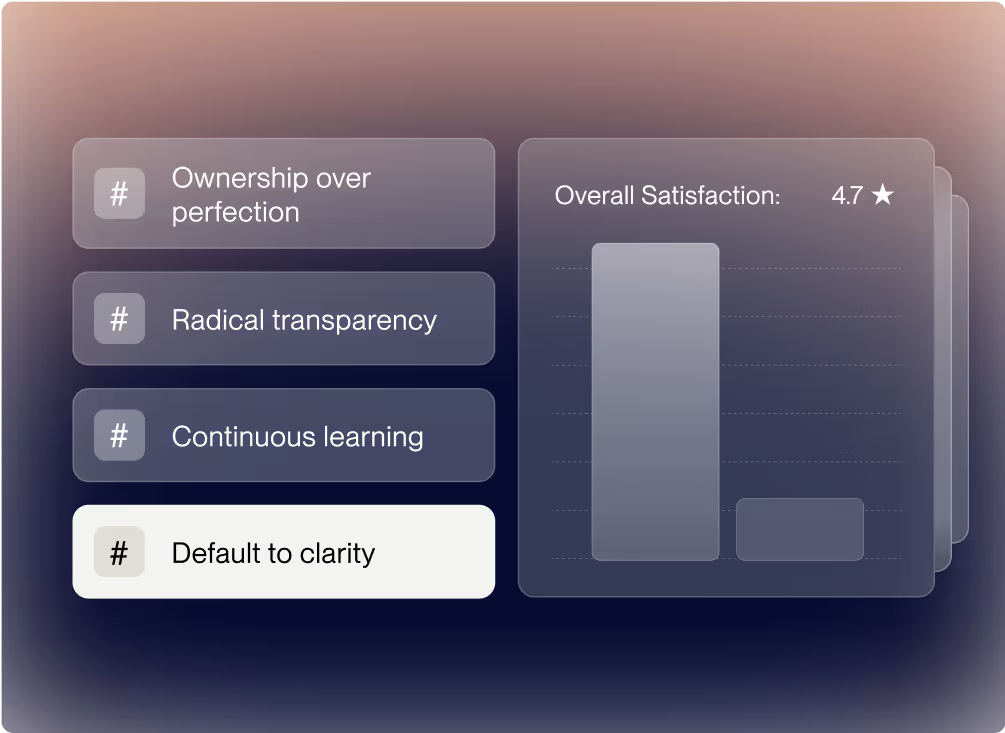Culture & Workplace Environment

Culture isn’t just fluff; it impacts your bottom line. Studies show that a positive workplace culture and connected team lead to increased productivity and revenue.
That’s right, if your culture results in happy and motivated employees who love coming to work every day, your startup will achieve higher revenue.
And of course, the opposite is true as well. Dysfunctional and toxic startup cultures often lead to dysfunctional businesses.
That’s why it’s important to create the kind of culture and workplace environment you want at your startup on Day 1.
What makes a positive workplace culture?
First, let’s break down what contributes to a positive workplace culture. As a leader at your startup, how you lead & manage has an outsized impact on your workplace culture. Here are a few factors to think about how you, as a CEO and founder, can build a positive culture.
1. Psychological safety
When employees feel safe to share their opinions freely (even if they contradict their boss’s opinion), your startup and product will benefit from the best and most innovative ideas.
What’s more, if they can experiment and make mistakes without repercussions, your startup will thrive and innovate faster than your competitors.
What you can do:
- Always listen
- Ask for opinions and feedback
- Be open to opposing opinions (after all, they help test your ideas)
- Encourage experimentation and failing forward
- Don’t penalize mistakes, learn from them
- Treat employees with respect and always communicate professionally
- Avoid knee-jerk responses and don’t get emotional or angry.
- Take a deep breath before you react negatively to something and think carefully about how you can respond constructively and empathetically.
2. Transparent & open communication
A thriving workplace culture relies on open and transparent communication from the top down and the bottom up. This two-way communication builds trust and employee engagement.
Secrecy and uncertainty at a startup often lead to a toxic work environment and result in disengaged employees, so you’ll want to avoid going down this path.
What you can do:
- Always keep your employees in the loop and communicate transparently, whether it’s good or bad news, at company meetings and on Slack.
- Create avenues for bottom-up feedback, allowing your employees to express their concerns and ask questions regularly.
3. Belonging, teamwork & collaboration
Studies show that high-performing teams are closely-knit teams built on strong bonds, friendship, and trust. Think of a winning sports team. When people feel like they are part of a team and community, they are more engaged, go the extra mile, and have fun while doing it.
Teams that are collaborative and have each other’s back — opposed to teams that are competitive and backstabbing— perform better.
However, don’t leave this to chance; you need to intentionally cultivate a sense of belonging, trust, and collaboration.
What you can do:
- Be inclusive by soliciting and valuing every employee’s opinions and inputs equally. Don’t play favorites.
- Build collaboration and teamwork rather than competition by ensuring open communication and shared decision-making. Streamline how information is shared so that everyone is kept informed. Ensure key people are included at meetings, meeting notes are shared, and key updates are provided during team meetings or on Slack. Encourage co-creation on projects and celebrate successful teamwork.
- Schedule fun and team-bonding activities that are open to everyone, like bowling, going on a hike together, or going out to lunch or dinner as a team.
- Organize a company retreat in a relaxing location, if budget permits. Combine work and training sessions with fun, team-bonding activities.
4. Shared company values
Shared company values create the foundation of your startup’s culture and a guidepost for employee behavior.
What you can do:
- You’ll want to be intentional and put pen to paper. Craft your “company values” with your co-founder and/or your OG team. These are usually 4 or 5 key company values that will serve as your startup’s cultural compass.
- And then really live and breathe these values. Don’t just make them live on a piece of paper.
- Use your company values as your yardstick when sizing up candidates to bring on board. There should always be a company values section in your interview scorecard, and create interview questions you can ask to evaluate candidates based on these values. For example, if collaboration is a company value, then screen candidates for this trait. The key to creating the kind of culture you want is bringing in people who share these values.
- Training is key to living by your cultural values. For example, if empathy is a key cultural value, then you’ll want to train you and your employees to develop this soft skill.
- Ensure that your employees embody these values. Reinforce your company's values by giving your employees regular positive recognition and constructive feedback. You may also want to incorporate company values into your performance evaluations.
- Give out employee-nominated awards. Recognize employees and teams who are aces at exhibiting your company values quarterly and announce them at All-Hands. (This will come at a later stage as your startup grows).
- Finally, role model these values yourself.
5. Learning, feedback & recognition
To motivate and engage your employees, you’ll want to create a culture that enables them to learn and grow through positive & constructive feedback loops as well as learning & development opportunities.
What you can do:
- Celebrate and recognize employee work regularly. Give frequent shoutouts at company meetings and on Slack.
- Provide positive and constructive feedback consistently and effectively, not just during annual performance reviews.
- Provide leadership and soft skills training for you and your leaders, especially if you are first-time managers. For example, you may want to offer a workshop, online course, or suggest a book for your employees, leaders, & yourself to learn how to give feedback effectively and empathetically. A leader who yells at employees when giving negative feedback is one of the fastest ways to slip into a toxic workplace culture.
- Offer learning & development opportunities. Your employees will no doubt be winging it in areas they know nothing about at times. That’s startup life. Consider paying for online courses on Udemy or LinkedIn in specific skill areas, so they can learn fast. It’s rewarding for them to grow and acquire a new skill, plus you ensure the project gets done right.
- Ensure you conduct compliance training. Finally, conduct the necessary training to be compliant with federal and state labor regulations. For example, in California, sexual harassment training is required for companies with 5 employees or more. Other important training that protects your company also includes IT security, data privacy, and DEI training.
6. Employee well-being & safety
Ensuring the physical and mental well-being of your employees is a key element of creating a positive and safe work environment. And it’s also required by law.
Federal and state regulations will require you to ensure a safe and fair workplace that protects your employees’ physical and emotional well-being.
For example, federal OSHA regulations enforce worker safety protection to prevent preventable injuries and illnesses.
What you can do:
- Protect your workforce through regular training, breaks, providing PPE, and regular monitoring, depending on your industry.
- Schedule regular OSHA consultations, display posters, handle any workplace hazards, and report any injuries in a timely fashion.
- For office workers, ensure that employee workstations are ergonomic and allow for regular stretch breaks.
- Encourage time off and work-life balance, so your employees have time to recharge. This will help their productivity in the long run, as exhausted workers lead to mediocre work or worse, mistakes.
- Provide healthcare benefits to support physical and mental health. All-in-one HR platforms offer healthcare benefits packages for startups. Find out how Every can support you.
Last step: Create an employee handbook
You may recall signing a student handbook with a code of conduct in school or an employee handbook at your previous workplace. And maybe you thought it was just fluff. Well, it’s not fluff.
An employee handbook lays down the framework for your company culture and how you expect your employees to behave. And most importantly, it protects you against employee lawsuits down the road.
Once you have hired a few employees, it may make sense to create an employee handbook.
Here’s why:
Your handbook is a great place to formalize your company values. An employee handbook also helps ensure compliance with any labor regulations and sets expectations.
It formalizes and communicates your company's policies on:
- Conduct and discipline
- Leave and time off
- Company values and code of conduct
- Remote work expectations
- Anti-harassment procedures
- Use of company devices and email
- Termination of employment
- Your handbook can protect you against potential lawsuits by clearly communicating your company’s policies, so there is no confusion when disputes arise.
- Always have an attorney review your handbook to ensure it's accurate and compliant with federal and state regulations before publishing it.
- Have your employees acknowledge these policies and sign the handbook. File these signed employee handbooks safely.
- Finally, regularly review your handbook and update it to reflect legal changes.
Resource: Indeed has an Employee Handbook template you can use as a starting point.
{{ebook-cta}}












